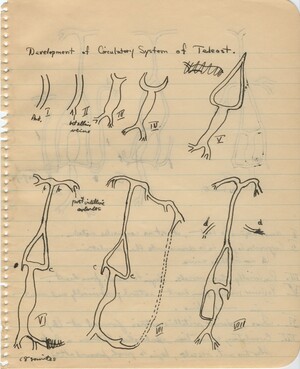“I certainly never knew how many parts a microscope has until I greased mine!” Frances Paul reported hearing fellow students exclaim as they put vaseline on all the metal parts of their microscopes during the first day of the course to keep them moving smoothly and to prepare for the five weeks of experiments. Students collected organisms, set-up the correct conditions for the embryos to develop, and observed them under the microscope, sometimes with the aid of vital dyes. The instructors brought their individual forte to the class to aid the experiments. Lecturer W. R. Duryee emphasized the roles of the nuclei of the fertilized egg, while Viktor Hamburger taught about his advisor Hans Spemann’s organizer concept, wherein a section of early stage embryo called the ‘organizer’ induces differentiation and organization of the emerging embryonic structures.
Most embryos or eggs required delicate, exacting operations. For example, the experimental manual for the course required that “Fundulus eggs should not be allowed to stand more than five minutes before fertilizing,” and that “plans and preparations should be carefully perfected before the experiment is started.” Experiments could also be laborious and time-consuming. One paragraph of the experimental instructions required days of labor and observation to finish. For example, the circulatory system of the fish had only five lines of instructions in the course manual, yet required each student to keep meticulous track of development, from the first sign of the extra embryonic body cavity, to the first action of the heart (about six days!) in order to obtain satisfactory diagrams.
Yet despite all the details of the experimental work, nothing was more rewarding than seeing long-expected results, or surprising discoveries. For instance, a Collecting Net story showed the students’ enthusiasm for even esoteric discoveries when it reported that “there was the famous night when one of the few live cunner developed a pronephros under the curious scrutiny of several members of the class who insisted that it was dead just because they couldn’t see the heart beating.” For such results, some were said to refrain from “joining the late afternoon exodus to the beach just to watch the gastrula form.”
Students were amazed by the sophisticated work done during the course. They learned to transplant nuclei from one embryo into another, which required steady nerves. They learned to create cyclopean monsters out of normal fish embryos by treating the embryos with alcohol or magnesium chloride. They watched the regeneration of truncated hydranths of coelenterates in the running seawater. The experiments on parthenogenesis especially induced great interest and “the loudest shouts of glee” when fatherless sea urchins were raised up to the pluteus stage.
Although the budding experimenters tried to follow the timing of the development of each organism closely, such pursuits sometimes did not pay off because their organisms’ pace went against scientists’ own circadian cycles. “The pursuit of a Sabellaria even led one eager scientist to lie in wait until 3:30 A. M. until the wary annelid finally was sighted, but sadly enough, the embryologist was so bleary-eyed by then that he couldn’t see straight enough to draw it!”

